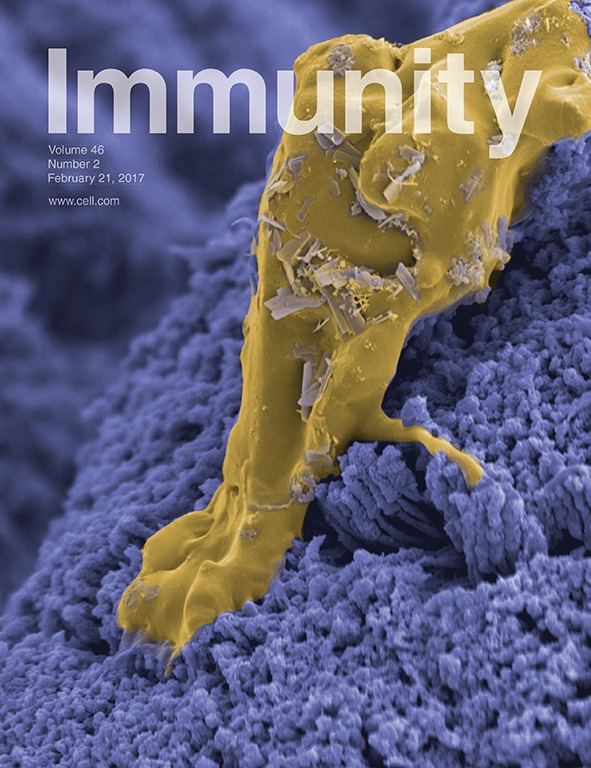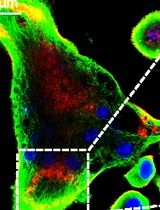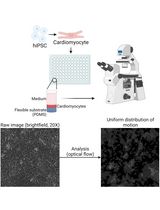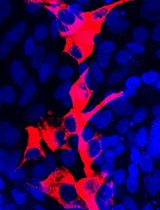- EN - English
- CN - 中文
Differentiation of Myeloid-derived Suppressor Cells from Murine Bone Marrow and Their Co-culture with Splenic Dendritic Cells
源自小鼠骨髓的骨髓源性抑制细胞的分化及其与脾树突状细胞的共培养
发布: 2017年09月20日第7卷第18期 DOI: 10.21769/BioProtoc.2558 浏览次数: 12231
评审: Ivan ZanoniMeenal SinhaAnonymous reviewer(s)
Abstract
Myeloid-derived suppressor cells (MDSCs) possess the ability to suppress the immune response, and to amplify the regulatory properties of other immune cells, i.e., dendritic cells. Here we describe a protocol in which MDSCs were differentiated from murine bone marrow cells, and CD11c+ dendritic cells were purified from murine spleens. MDSCs and CD11c dendritic cells can be co-cultured and the immunoregulatory phenotype of the MDSCs-conditioned dendritic cells could be assessed by means of a specific functional in vivo experiment, i.e., a skin test as a measure of the delayed-type hypersensitivity reaction toward a poorly immunogenic antigen.
Keywords: Myeloid-derived suppressor cells (骨髓源性抑制细胞)Background
The myeloid-derived suppressor cells (MDSCs) are a group of myeloid cells comprised of precursor of macrophages, granulocytes, dendritic cells and myeloid cells at earlier stages of differentiation (Youn et al., 2008) accumulating in large numbers in lymphoid tissues of tumor-bearing mice as well as in mice with infectious diseases, sepsis and trauma. The main feature of these cells is their ability to suppress T cell responses in Ag-specific and/or nonspecific fashion. These cells are now considered as one of the major cell type responsible for tumor-associated immune defects; main factors implicated in MDSC-mediated immune suppression include high expression of Arg1 (Marvel and Gabrilovich, 2015). Arginase 1 (Arg1) and indoleamine 2,3-dioxygenase 1 (IDO1) are immunoregulatory enzymes catalyzing the degradation of L-arginine (L-Arg) and L-tryptophan (L-Trp), respectively, resulting in local amino acid deprivation. In addition, unlike Arg1, IDO1 is also endowed with non-enzymatic signaling activity in dendritic cells (DCs) (Mondanelli et al., 2017). In addition to their inherent immunosuppressive activity, MDSCs might amplify regulatory properties of other immune cells, particularly in tumor microenvironments. Although some mechanisms underlying MDSC-macrophage interaction have been established (Ugel et al., 2015), the cross-talk between MDSCs and DCs is still unclear (Ostrand-Rosenberg et al., 2012); to fill this gap, we have developed this protocol and we demonstrated that Arg1+ MDSCs confer to DCs an IDO1-dependent, immunosuppressive phenotype via Arg1 metabolites (i.e., polyamines such as putrescine and spermidine) (Mondanelli et al., 2017). The Arg and Trp immunoregulatory pathways are functionally integrated, this integration occurring both intra- (i.e., DCs) and inter-cellularly (MDSCs and DCs) (Mondanelli et al., 2017).
Materials and Reagents
- Petri dishes (Corning, Falcon®, catalog number: 351029 )
- 15 ml Falcon tubes (Corning, Falcon®, catalog number: 352096 )
- Cell strainers (Corning, Falcon®, catalog number: 352340 )
- 5 ml sterile pipettes (Corning, Falcon®, catalog number: 357543 )
- 10 ml sterile pipettes (Corning, Falcon®, catalog number: 357551 )
- 200 µl sterile tips (Biotix, Neptune®, catalog number: 2102 NS )
- 1,000 µl sterile tips (Biotix, Neptune®, catalog number: 2372 S )
- 24-well plates (Corning, Falcon®, catalog number: 353047 )
- 50 ml Falcon tubes (Corning, Falcon®, catalog number: 352070 )
- 10 ml syringe (Terumo Medical, catalog number: SS+10S21381 )
- 1 ml syringe with 26 G ½ needle (Terumo Medical, catalog number: SS+01H26131 )
- 2 ml syringe plunger (Terumo Medical, catalog number: SS-02S2238 )
- 6-well plates (Corning, Falcon®, catalog number: 353046 )
- Permeable support for 24-well plate with 0.4 μm translucent high density PET membrane (Corning, Falcon®, catalog number: 353495 )
- LS columns (Miltenyi Biotec, catalog number: 130-042-401 )
- MS columns (Miltenyi Biotec, catalog number: 130-042-201 )
- Pasteur pipette (Sigma-Aldrich, catalog number: Z627992-1000EA )
- C57BL/6 female mice, 6 weeks old (C57BL/6NCrl) (Charles River Laboratories, catalog number: 027 )
- RPMI 1640 medium (Thermo Fisher Scientific, catalog number: 11875093 )
- FCS (Thermo Fisher Scientific, catalog number: A3160801 )
- L-Glutamine (Thermo Fisher Scientific, catalog number: 25030024 )
- Penicillin-streptomycin (Thermo Fisher Scientific, GibcoTM, catalog number: 15140122 )
- HEPES (Thermo Fisher Scientific, catalog number: 15630056 )
- 2-Mercaptoethanol (Thermo Fisher Scientific, GibcoTM, catalog number: 31350010 )
- Trypan blue (Thermo Fisher Scientific, GibcoTM, catalog number: 15250061 )
- Phosphate buffered saline (PBS) (Thermo Fisher Scientific, GibcoTM, catalog number: 10010023 )
- Bovine serum albumin (BSA) (Rockland Immunochemicals, catalog number: BSA-50 )
- Ethylenediaminetetraacetate acid (EDTA) (AppliChem, catalog number: 131669.1211 )
- CD11b MicroBeads, human and mouse (Miltenyi Biotec, catalog number: 130-049-601 )
- CD11c MicroBeads UltraPure, mouse (Miltenyi Biotec, catalog number: 130-108-338 )
- HBSS, no calcium, no magnesium (Thermo Fisher Scientific, catalog number: 14170088 )
- Sodium chloride (NaCl) (CARLO ERBA Reagents, catalog number: 479687 )
- Tris (Bio-Rad Laboratories, catalog number: 1610719 )
- Potassium chloride (KCl) (CARLO ERBA Reagents, catalog number: 471177 )
- Recombinant murine GMCSF (PeproTech, catalog number: 315-03 )
- Recombinant murine IL-4 (PeproTech, catalog number: 214-14 )
- Collagenase from Clostridium histolyticum (Sigma-Aldrich, catalog number: C5138-1G )
- Histodenz (Sigma-Aldrich, catalog number: D2158-100G )
- Nor-NOHA (Cayman Chemicals, catalog number: 10006861 )
- MACS buffer (see Recipes)
- RPMI medium (see Recipes)
- TCCM (see Recipes)
- Collagenase 100 U/ml and 400 U/ml (see Recipes)
- Nycodenz (see Recipes)
- Nycodenz buffer (see Recipes)
Equipment
- Scissor (Isolab Laborgeräte, catalog number: 048.25.130 )
- Sterile biosafety cabinet
- P20L pipette (Pipetman L) (Gilson, catalog number: FA10003M )
- P200L pipette (Pipetman L) (Gilson, catalog number: FA10005M )
- P1000L pipette (Pipetman L) (Gilson, catalog number: FA10006M )
- Pipet controller (Corning, Falcon®, catalog number: 357471 )
- Centrifuge (Eppendorf, model: 5810 R )
- Incubator (Thermo Fisher Scientific, Thermo ScientificTM, model: BB15 )
- -80 °C freeze (Thermo Fisher Scientific, Thermo ScientificTM, model: FormaTM 88000 Series )
- Light microscope (ZEISS Primostar)
- MiniMACS separator (Miltenyi Biotec, catalog number: 130-042-102 )
- MidiMACS separator (Miltenyi Biotec, catalog number: 130-042-302 )
Procedure
文章信息
版权信息
© 2017 The Authors; exclusive licensee Bio-protocol LLC.
如何引用
Mondanelli, G. and Volpi, C. (2017). Differentiation of Myeloid-derived Suppressor Cells from Murine Bone Marrow and Their Co-culture with Splenic Dendritic Cells. Bio-protocol 7(18): e2558. DOI: 10.21769/BioProtoc.2558.
分类
免疫学 > 免疫细胞分化 > MDSC
细胞生物学 > 细胞分离和培养 > 细胞分化
您对这篇实验方法有问题吗?
在此处发布您的问题,我们将邀请本文作者来回答。同时,我们会将您的问题发布到Bio-protocol Exchange,以便寻求社区成员的帮助。
Share
Bluesky
X
Copy link













